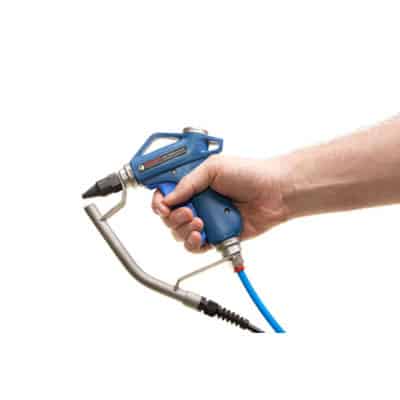It’s That Shocking Time of the Year
Ethanol; Intoxicating or Explosive?
This week, especially because it’s December and so close to the Christmas holiday, I worked on an alarming application that involved a static hazard. 100% ethanol was poured from a plastic container, which held approximately 5 gallons of the liquid, into smaller or larger containers that were also made of plastic. Ethanol is a colorless, volatile liquid. Most people recognize it as the ingredient in liquor, which has an intoxicating effect on most people. However, it is also used as a solvent which can ignite under certain conditions. Static electricity is one of the three components necessary to create an event, which is a soft way of saying an arc-over, a fire or an explosion. The other two ingredients are oxygen and a volatile vapor.
There are well established protocols for handling and working with ingredients that can go “boom in the night”. The front line of defense in protecting oneself from mishaps is grounding everything that is capable of being grounded. If we take a simplistic approach and look at the world as being made of only two materials, insulators and conductors, you can get a better sense of safety procedures that will keep to us out of harm’s way. Metal is a conductor and easily grounded by clamping onto a known building ground or electrical ground or even by driving a rod deep into the earth. Hence, we call it an earth ground. A water pipe inside of a facility can also act as a good ground source. By grounding the metal, electrons can flow through the metal to ground itself. Conversely plastic cannot be grounded. This is why my static application hit a bump in the road. Static is generated on plastic materials through friction which we call Tribocharging. There are a myriad of types of plastic, but for the most part, assume that all plastics are huge static generators. Plastics are insulators and not conductive so the energy generated by simply handling plastic stays on the surface and can be a source of ignition.
Static Hazard
In my static hazard application, an ungrounded person holding the ethanol picks up an ungrounded plastic container and pours it into another ungrounded container. This is not a good situation. During the pouring process, a potentially explosive, volatile vapor cloud forms around the pouring action in both the dumping container and the receiving container. There are three possible opportunities that can cause ignition in this scenario: a discharge from the ungrounded tech who is pouring the flammable ethanol; a discharge from static on the container which is high enough in proximity to the vapor cloud which forms in the discharging plastic container; a discharge from static to the same cloud that can form in the receiving plastic container. If a static charge is present, with enough energy behind it, there is a strong chance that any of these actions can create a safety hazard.
A Grounding Solution
Finding a solution to this problem can be a bit tricky. The basic approach is to ground everything that can be grounded or switch to materials that can be grounded. Simply switching from plastic containers to metal is a huge step in the right direction. There will be times when grounding is not possible and materials cannot be changed. In that case, ionization is the only choice. There are approved ionizing static bars and blowers that remove or greatly reduce static electricity on plastic materials. Static Clean and Fraser AntiStatic Techniques of England have formed a strategic alliance / partnership to address these dangerous scenarios. When you have concerns about your facility and the safety of workers who may be in harm’s way, please reach out to Static Clean for help. At this special time of year as with any time of year, it is important to always think “safety first”.



 A Higher Standard of Clean
A Higher Standard of Clean